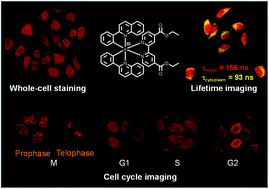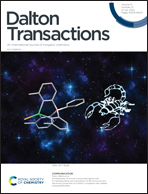Cellular imaging properties of phosphorescent iridium(iii) complexes substituted with ester or amide groups†
Abstract
Phosphorescent iridium(III) complexes have been extensively investigated as cellular imaging reagents and sensors. The intracellular localization of the complexes is known to be closely related to their formal charge, molecular size, lipophilicity, and bioactive pendants. Herein, we reported four phosphorescent iridium(III) complexes with the diimine ligands being modified with ester or amide groups as imaging reagents for living cells. The complexes have the same positive charge and very similar molecular size and weight. The lipophilicity of the complexes is similar ranging from 1.45 to 2.14. Upon internalization into living HeLa cells, while complexes 2–4, like most other iridium(III) complexes, were localized in the cytoplasm, complex 1 unexpectedly stained the whole cells including nuclei. The nuclear uptake of complex 1 was not observed when the cells were pretreated with chlorpromazine or nocodazole, suggesting that clathrin and microtubules mediated the nuclear uptake of complex 1. Additionally, the nuclear uptake efficiency is related to the cell division cycle. The complex was mainly concentrated in the nucleus when the cells were in mitosis, and distributed in whole cells when the cells were in the interphases. Furthermore, complex 1 exhibited a longer luminescence lifetime in the nucleus than in the cytoplasm as revealed by photoluminescence lifetime imaging microscopy (PLIM). Incubation of the cells in the hypoxia environment elongated the lifetime of the cytoplasmic complex, but hardly affected the luminescence properties of the intranuclear complex.



 Please wait while we load your content...
Please wait while we load your content...